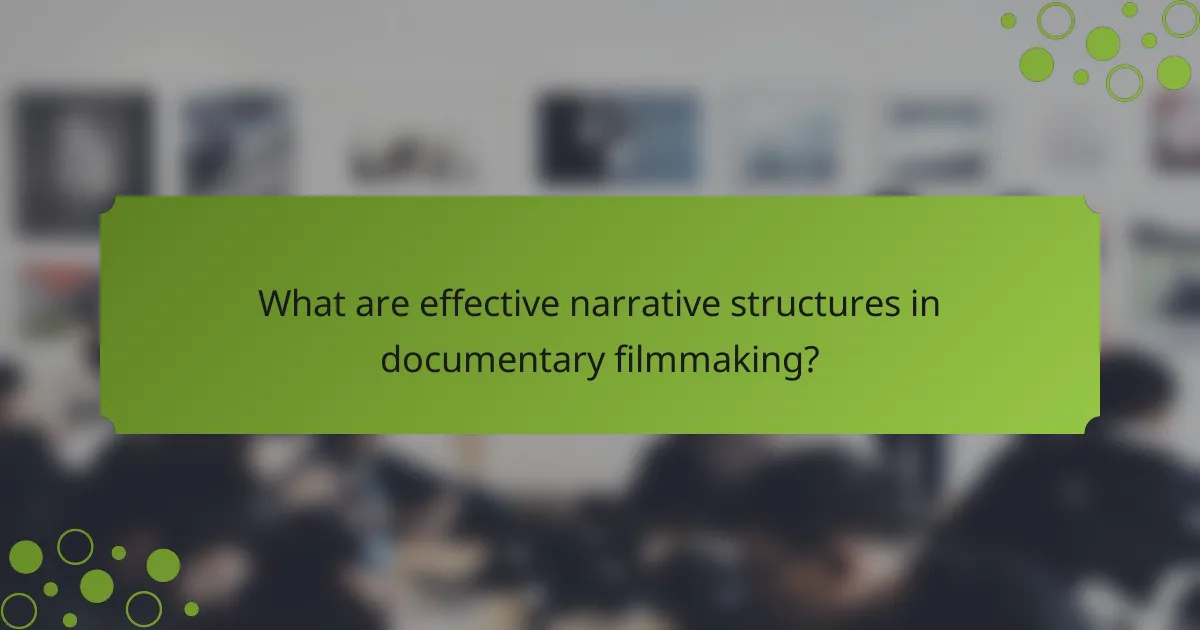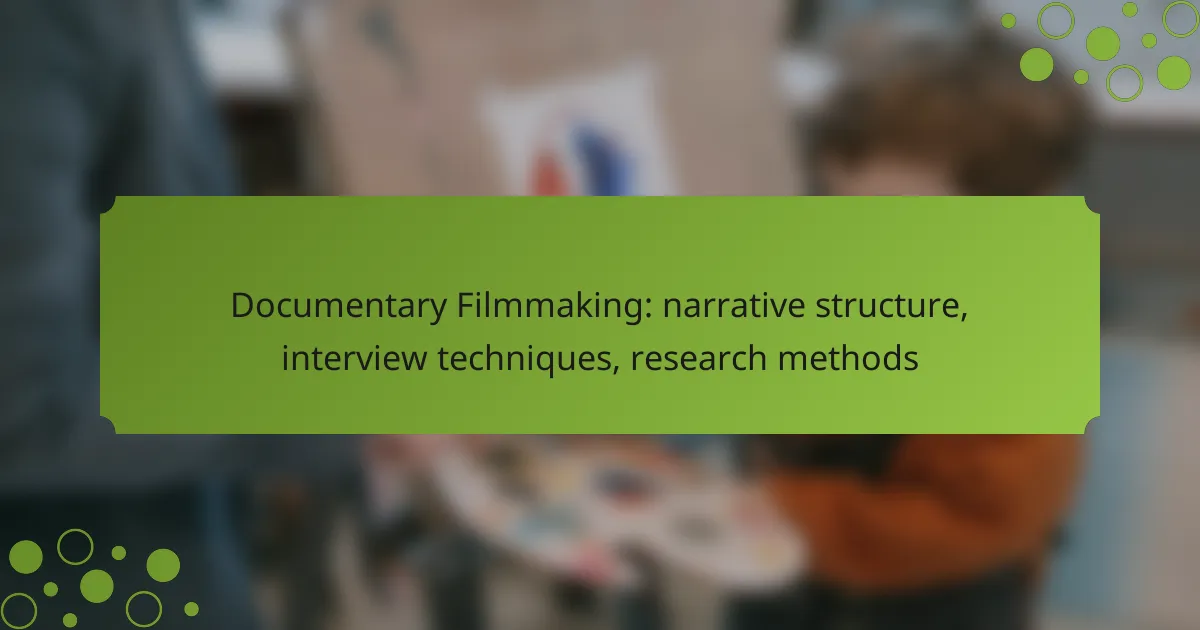Documentary filmmaking relies on effective narrative structures to engage audiences and convey compelling stories. By employing insightful interview techniques and thorough research methods, filmmakers can enhance the authenticity and depth of their narratives, ensuring that viewers connect meaningfully with the subject matter.

What are effective narrative structures in documentary filmmaking?
Effective narrative structures in documentary filmmaking help convey the story in a compelling way, guiding the audience through the subject matter. Choosing the right structure can enhance emotional engagement and clarify the message, making it easier for viewers to connect with the content.
Three-act structure
The three-act structure divides the documentary into three distinct parts: setup, confrontation, and resolution. This classic framework allows filmmakers to introduce characters and themes, present challenges or conflicts, and ultimately provide a resolution or insight. For example, a documentary about climate change might start with the current state of the environment, then explore the challenges faced, and conclude with potential solutions.
Linear narrative
A linear narrative presents events in chronological order, making it straightforward for viewers to follow the progression of the story. This structure is effective for documentaries that rely on historical events or personal journeys, as it allows for a clear timeline. An example could be a biography that traces an individual’s life from childhood to adulthood, highlighting key moments along the way.
Circular narrative
A circular narrative begins and ends at the same point, creating a sense of closure and reflection. This structure can emphasize themes or messages by revisiting the starting point after exploring various aspects of the story. For instance, a documentary about a community’s struggles might start with a current issue, delve into its history, and return to the present to show how the community has evolved.
Non-linear narrative
Non-linear narratives present events out of chronological order, allowing for a more complex exploration of themes and character development. This approach can create suspense or intrigue, as viewers piece together the story from various perspectives. A documentary that jumps between different time periods or locations can effectively illustrate how past events influence the present.
Character-driven narrative
Character-driven narratives focus on individuals’ stories to convey broader themes and issues. This structure allows audiences to connect emotionally with the subjects, making the documentary more impactful. For example, a film about social justice might follow the lives of several activists, showcasing their personal experiences and motivations while addressing systemic problems.

How can I conduct impactful interviews for documentaries?
Conducting impactful interviews for documentaries involves asking insightful questions and creating a comfortable environment for subjects to share their stories. Effective techniques can enhance the depth and authenticity of the information gathered.
Open-ended questions
Open-ended questions encourage subjects to provide detailed responses rather than simple yes or no answers. For instance, instead of asking, “Did you enjoy your experience?” you might ask, “What was the most memorable part of your experience?” This approach invites richer narratives and insights.
When formulating open-ended questions, aim for clarity and relevance to the documentary’s theme. Use prompts that allow for elaboration, such as “Can you describe how that event affected you?” This technique fosters a more engaging dialogue.
Active listening techniques
Active listening is crucial for impactful interviews, as it shows subjects that their words are valued. Techniques include nodding, maintaining eye contact, and using verbal affirmations like “I see” or “That’s interesting.” These cues encourage subjects to continue sharing their thoughts.
Additionally, summarizing or paraphrasing what the subject has said can demonstrate understanding and prompt further elaboration. For example, saying, “So, you felt overwhelmed during that time?” can lead to deeper insights into their experiences.
Building rapport with subjects
Building rapport is essential for creating a trusting atmosphere during interviews. Start by introducing yourself and sharing a bit about your project, which can help subjects feel more comfortable. Personalizing the interaction by finding common interests can also strengthen the connection.
Be mindful of body language and tone; a warm, open demeanor can make subjects more willing to share personal stories. Avoiding judgmental reactions and showing empathy can further enhance the relationship, leading to more authentic responses.
Using follow-up questions
Follow-up questions are vital for diving deeper into a subject’s responses. After an initial answer, ask questions like, “Can you tell me more about that?” or “What happened next?” This encourages subjects to expand on their thoughts and provides richer content for the documentary.
Be attentive to the flow of conversation; sometimes, a spontaneous follow-up based on the subject’s response can yield the most compelling insights. Avoid interrupting, and instead, allow pauses for subjects to gather their thoughts before responding.

What research methods enhance documentary filmmaking?
Effective research methods are crucial for enhancing documentary filmmaking by providing depth and authenticity. Utilizing a combination of primary and secondary sources, along with field research and expert interviews, can significantly enrich the narrative and credibility of the film.
Primary source analysis
Primary source analysis involves examining original materials directly related to the documentary’s subject. This can include interviews, photographs, letters, and archival footage. By analyzing these sources, filmmakers can gain firsthand insights and unique perspectives that add authenticity to their narrative.
When conducting primary source analysis, it is essential to verify the credibility of the sources. Cross-referencing information and understanding the context in which the material was created can help avoid misrepresentation.
Secondary source review
Secondary source review entails evaluating existing literature, articles, and documentaries that relate to the topic. This method helps filmmakers understand the broader context and existing narratives surrounding their subject. It can also reveal gaps in the current discourse that the documentary can address.
While reviewing secondary sources, filmmakers should focus on reputable publications and peer-reviewed articles. This ensures that the information is reliable and can support the documentary’s claims effectively.
Field research techniques
Field research techniques involve gathering data directly from the environment related to the documentary’s theme. This can include observational studies, surveys, and participant observation. Engaging with the subject matter in real-world settings allows filmmakers to capture authentic moments and interactions.
When employing field research, filmmakers should be prepared for unexpected challenges, such as logistical issues or unanticipated responses from subjects. Flexibility and adaptability are key to making the most of field research opportunities.
Expert interviews
Expert interviews are a valuable method for obtaining in-depth knowledge and insights from individuals with specialized knowledge related to the documentary’s topic. These interviews can provide context, clarify complex issues, and lend credibility to the narrative.
To conduct effective expert interviews, filmmakers should prepare thoughtful questions that encourage detailed responses. Building rapport with the interviewee can also lead to more candid and informative discussions. Always ensure that consent is obtained and that the interviewee is aware of how their contributions will be used in the film.

What are the prerequisites for a successful documentary project?
A successful documentary project requires a clear understanding of the target audience, a well-defined vision, and adequate budgeting and funding. These elements are crucial for guiding the production process and ensuring the documentary resonates with viewers.
Defining the target audience
Identifying the target audience is essential for shaping the documentary’s content and style. Consider demographics such as age, interests, and cultural background to tailor the narrative effectively.
Engaging with potential viewers through surveys or focus groups can provide valuable insights. This feedback helps refine the approach and ensures the documentary addresses the audience’s needs and expectations.
Establishing a clear vision
A clear vision serves as the foundation for the documentary, guiding the storytelling and visual style. Define the core message and themes you want to convey, ensuring they align with the interests of your target audience.
Creating a treatment or outline can help crystallize your vision. This document should detail the narrative structure, key scenes, and potential interview subjects, providing a roadmap for the production process.
Budgeting and funding options
Budgeting is a critical step in documentary filmmaking, as it determines the scope and quality of the project. Outline all potential costs, including equipment, crew, travel, and post-production expenses, to create a realistic budget.
Explore various funding options such as grants, crowdfunding, and sponsorships. Many filmmakers utilize platforms like Kickstarter or Indiegogo to raise funds, while others may seek support from arts organizations or film festivals that offer financial assistance.

What are common challenges in documentary filmmaking?
Documentary filmmaking presents several challenges that can impact the final product. Key issues include gaining access to subjects, managing time constraints, and navigating ethical considerations.
Access to subjects
Securing access to interview subjects can be one of the most significant hurdles in documentary filmmaking. Filmmakers often need to build trust and rapport with potential subjects, which can take time and effort. It’s essential to approach subjects respectfully and be transparent about the documentary’s purpose.
Consider using a variety of outreach methods, such as social media, community events, or networking through mutual contacts. This can increase your chances of obtaining interviews with diverse perspectives.
Time constraints
Time constraints can severely limit the depth and quality of a documentary. Filmmakers often work under tight deadlines, which can affect research, filming, and editing processes. It’s crucial to prioritize tasks and set realistic timelines for each phase of production.
To manage time effectively, create a detailed production schedule that includes milestones for research, filming, and post-production. Regularly review and adjust your timeline to accommodate any unforeseen delays.
Ethical considerations
Ethical considerations are paramount in documentary filmmaking, as filmmakers must navigate issues of consent, representation, and potential harm to subjects. It’s vital to obtain informed consent from participants and to be sensitive to their stories and experiences.
Establish clear ethical guidelines for your project, and consider consulting with ethics boards or experienced filmmakers. This can help ensure that your documentary respects the dignity of its subjects while conveying their stories authentically.
